cellulase
- CAS No.
- 9012-54-8
- Chemical Name:
- cellulase
- Synonyms
- cellulase enzyme;Acid cellulase;Celluase;MEICELASE;Definition;Celluclast 1.5L;ACLA;Cel7A;26921;800NSK
- CBNumber:
- CB6402855
- Molecular Formula:
- NULL
- Molecular Weight:
- 0
- MDL Number:
- MFCD00081510
- MOL File:
- Mol file
- MSDS File:
- SDS
| Density | 1.2 g/mL at 25 °C |
|---|---|
| vapor pressure | 0.004Pa at 25℃ |
| storage temp. | 2-8°C |
| solubility | deionized water: soluble5.0mg/mL (Sterile; In the presence of 0.15% polyhexamethylene biguanide (PHMB).) |
| form | powder |
| color | white |
| Water Solubility | Soluble in cold water. |
| LogP | -1.3 at 20℃ |
| FDA 21 CFR | 310.545 |
| EWG's Food Scores | 1 |
| FDA UNII | C1VIJ1EPFS |
| EPA Substance Registry System | Cellulase (9012-54-8) |
SAFETY
Risk and Safety Statements
| Symbol(GHS) |  GHS08 |
|||||||||
|---|---|---|---|---|---|---|---|---|---|---|
| Signal word | Danger | |||||||||
| Hazard statements | H334 | |||||||||
| Precautionary statements | P261-P342+P311 | |||||||||
| Hazard Codes | Xn,Xi | |||||||||
| Risk Statements | 42 | |||||||||
| Safety Statements | 22-24-36/37-2-45-23 | |||||||||
| WGK Germany | 1 | |||||||||
| RTECS | FJ5375000 | |||||||||
| F | 3-10 | |||||||||
| TSCA | Yes | |||||||||
| HS Code | 35079090 | |||||||||
| NFPA 704 |
|
cellulase price More Price(31)
| Manufacturer | Product number | Product description | CAS number | Packaging | Price | Updated | Buy |
|---|---|---|---|---|---|---|---|
| Sigma-Aldrich | C8546 | Cellulase from Trichoderma reesei ATCC 26921 lyophilized powder, ≥1?unit/mg solid | 9012-54-8 | 2500Units | $65 | 2024-03-01 | Buy |
| Sigma-Aldrich | C8546 | Cellulase from Trichoderma reesei ATCC 26921 lyophilized powder, ≥1?unit/mg solid | 9012-54-8 | 5000units | $115 | 2024-03-01 | Buy |
| Sigma-Aldrich | C8546 | Cellulase from Trichoderma reesei ATCC 26921 lyophilized powder, ≥1?unit/mg solid | 9012-54-8 | 10000units | $201 | 2024-03-01 | Buy |
| Sigma-Aldrich | C1794 | Cellulase from Trichoderma sp. BioReagent, suitable for plant cell culture, 3-10?units/mg solid | 9012-54-8 | 5000units | $173 | 2024-03-01 | Buy |
| Sigma-Aldrich | C1184 | Cellulase from Aspergillus niger powder, ≥0.3?units/mg solid | 9012-54-8 | 5000units | $62 | 2024-03-01 | Buy |
cellulase Chemical Properties,Uses,Production
Brief Introduction
Cellulase naturally occurs in plant tissues; wherein it acts as a reinforcing material. It is thick and viscous in its physical arateristics, which makes it ideal for adding to foods and beverages to make ingredients combine and congealtogether. Cellulase is found in all plants and is quite abundant. Actually, it is the most widespread organic compound and is found in every habitat around the world. Its abundance and ease of acquisition make cellulase an ideal additive to foods and drinks, because it is cheap and easy to extract. Cellulase, as a nutrient, belongs to the category of roughage or fiber. Its binding properties make it popular among large-scale food and drink industries, who use it produce fruit juice, sparkling waters, spirits and other alcoholic beverages. When combined with other enzymes, cellulase is applied to produce wine; here its role is to extract foreign and unwanted substances from grape skins. In less quantities, cellulase is added as a congealant to washing and cleaning agents.
Chemical properties
It appears as off-white amorphous powder or liquid. It is soluble in water, almost insoluble in ethanol, chloroform and ether. It is relatively stable against heat. Even after being heated at 100 ℃ for 10min, it can still maintain 20% of the original activity. The general optimum temperature is 50~60 ℃, the optimum Ph value is 4.5~5.5.
Biological enzymes
Cellulase is a group of enzymes that catalyze the hydrolysis of cellulose to produce glucose and low polymerizing fibers, including three major components of dextran endonuclease, dextran exonuclease and cellobietase. It is not a single enzyme, but a synergistic multi-component enzyme system. Cellulase is an off-white powder or liquid. In 1906, Seilliere found the cellulase in the digestive solution of the snail. The cellulase hydrolyzes the β-1, 4-glucosidic linkages in the fibers to produce soluble polymers and D-glucose. Endocellulase breaks down internal bonds that it interrupts the cellulose’s crystalline structure, causing the exposure of cellulose polysaccharide chains.
Exocellulase continues the process of endocellulase by breaking down the ends of the particular chains into maximum 4 units. That’s how disaccharides or tetrasaccharides like the cellobiose appear. Exocellulases were found in 2 forms: CBHII acts at the non-reducing cellulose end while the CBHI acts at the reducing end.
Beta-glucosidase or cellobiase usually hydrolyses the above mentioned exocellulase and produces monosaccharides. The oxidative cellulase uses radical reactions like dehydrogenase and cellobiose to depolymerize cellulose. The activity of cellulase is commonly to split cellulose and convert it into beta-glucose. The symbiotic bacteria of herbivores produce this form of cellulase. Humans and other animals, besides ruminants, cannot generate this form of cellulase. Thus, they can split it only partially by using fermentation and they are not able to utilize the energy from the fibrous plants.
According to the source of the enzyme, the relative molecular mass of the lowest 5000, up to 400000. The optimum pH is 4.0 to 5.0. The optimum temperature is 40~60 ℃. Some of the metal ions Mg2 +, Cl2 + and neutral salts can activate the enzyme, and some other metal ions Ag2 +, Cu2 +, Mn2 +, Hg2 + and dyes can inactivate the enzyme.
The addition of cellulase to the wine can improve the saccharification effect and the liquor yield, and reduce the viscosity of the mash. Cellulase mainly comes from Aspergillus Niger and Trichoderma.
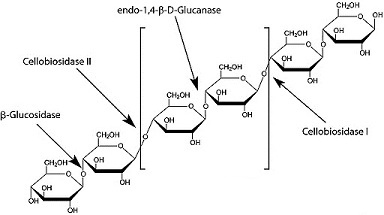
Figure 1 the molecular structural formula of the cellulase
Source
The source of cellulase is very broad. Insects, mollusks, protozoa, bacteria, actinomycetes, fungi and so can all produce cellulase.
1. Bacteria: Bacteria produce a lower amount of cellulase, mainly EG, most of which are not active against crystalline cellulose, and the resulting enzyme is an intracellular enzyme or adsorbed on the bacterial wall and rarely secreted into the extracellular which increases the difficulty of extraction and purification. Therefore, in practice, bacteria are rarely used in industry. At present, more research focuses on the cellulose slime, Anoeba limax Duzardin and fibrobacter.
2. Actinomyces: Very few studies focus on actinomycetes. Mycobacterium and the original actinomycete produce almost no cellulase or have low yield; species produce a relatively high amount include black and red spin actinomycetes, rose actinomycetes, actinomycetes cellulosae and white rose actinomycetes.
3. Fungi: Current microorganisms used in the production of cellulase mostly belong to fungi with more studies focusing on Trichoderma, Aspergillus, Rhizopus and Peculiar mold. They can produce a large number of cellulase, especially for Trichoderma. Trichoderma reesei and Trichoderma viride are fungi with high enzyme activity in Trichoderma. The fungi can produce three types of cellulase, being able to be secreted into the bacteria. They generally don’t gather to form a multi-enzyme complex, but having a strong synergistic effect with each other. At present, its preparations include cellulase from Trichoderma viride, Aspergillus Niger, Fusariumsis, Paecilomyces and Penicillium decumbens and other cellulase.
Microorganisms of the genera Trichoderma and Aspergillus are regarded to be cellulase producers, and crude enzymes produced by these microorganisms are commercially available for use in agriculture. Microorganisms of the genus Trichoderma produce comparatively large quantities of endo-ß-glucanase and exo-ß-glucanase, but only low levels of ß-glucosidase, while those of the genus Aspergillus produce comparatively large quantities of endo-ß-glucanase and ß-glucosidase with low levels of exo-ß-glucanase production.
4. Yeast: Due to the demand for industrial production of cellulase, it is required to increase enzyme production, exocrine and heat resistance. Recently, more and more research has been done on cellulase gene cloning. Although almost all of the cloned genes can be expressed in E. coli, but due to extraction difficulties and low level of expression, the current gene expression research has been transferred to the eukaryotic expression system. Yeast expression systems are mostly applied currently. Yeast does not produce toxins. Apply it for the expression of cellulase gene, the product is highly glycosylated. After correct processing and modification, it can be directly secreted into the medium with the expression level being high. For example, the yield of the CHB Ⅱ, EG Ⅰ expressed in yeast is up to 100mg/L or more, and has a normal biological activity.
Category
Cellulase includes a variety of hydrolases, belonging to a class of complex enzymes. Generally cellulase is divided into three categories:
1. Endoglucanase, also known as endo-(1 → 4)-β-D-glucanase, endo-cellulase or (1 → 4)-β-D-glucan-1, 4-glucan hydrolase (EC 3.2.1.4), which catalyzes any sites within the cellulose amorphous region or the (1 → 4)-β-D-glucan chain on the surface of microfilament.
2. Exo-glucanase, also known as exo (1 → 4)-β-D-glucanase, extracellular cellulase or (1 → 4)-β-D-glucan disaccharide hydrolase (EC 3.2.1.91), it is capable to release the cellobiose (sometimes with a small amount of glucose) through enzymatic digestion on the non-reducing end of the β-D-glucan chain.
3. β-glucosidase, also known as cellobiose or β-D-glucoside glucohydrolase (EC 3.2.1.21), being able to hydrolyze cellobiose and water-soluble fiber dextrin into glucose.
The mode of action of each of these is as follows:
(1) Endo-p-glucanase, 1,4-ß-D-glucan glucanohydrolase, CMCase, Cx: "random" scission of cellulose chains yielding glucose and cello-oligo saccharides.
(2) Exo-P-glucanase, 1,4-ß-D-glucan cellobiohydrolase, Avicelase, C1: exo-attack on the non-reducing end of cellulase with cellobiose as the primary structure.
(3) ß-glucosidase, cellobiase: hydrolysis of cellobiose to glucose.
Many kinds of cellulose degrading strains can produce a variety of isozymes. Organisms capable of degrading cellulose mainly include a large number of fungi, some bacteria and a few protozoa, but its degradation property depends on the polymerization and crystallinity of cellulose and the degree of binding with hemicellulose and lignin. Crystalline cellulose is highly resistant to the degradation of cellulase, and most of the glucan chains in microfilament are not accessible to the cellulase. Moreover, any hydrogen bonds that have been cleaved by endoglucanase are easy to reform due to the stabilizing trend of the dextran chain. The degradation of crystalline cellulose must be mediated through the synergistic interactions of both endoglucanase and exoglucanase. The exoglucanase removes the cellobiose from the newly created terminal formed after the action of the endoglucanase, thereby preventing the re-formation of the glycosidic bond. These two enzymes play a coherent and coordinating effect, but they are all inhibited by cellobiose, and the action of beta-glucanase is usually the rate-limiting step in cellulose degradation. Cellulase is a class of inducible enzymes and is repressed by catabolic products. Sophora is an excellent natural inducer of cellulase. Suppressors include glucose and other readily available substrates. Depending on the concentration, the cellobiose is either an inducer or a repressor.
Application in Detergent Industry
Fibrous fabrics, especially cotton fiber fabrics, often generate many microfiber fluffs after wearing and multiple laundering. These fluffs are wrapped together with organic and inorganic stains to form a lot of balls, resulting in darker and hardened surfaces of the clothes. To solve this problem, as early as 1970, it had been put forward in foreign patents of the idea of using fiber enzymes to eliminate these microfibers, but the idea had failed to become the reality for a long time. It was until 1985, used of the method of fermentation of Rhizopus sp. to make the world's first detergent-purpose cellulase. The product was named Cellulase. In 1987, a bacterial cellulase was introduced and successfully used in Attack detergent. Since then, cellulase also officially joined the ranks of detergent enzymes. Now, the application of cellulase in detergent is not too popular, but the brand-name products of some large companies have already used it. For example, the United States P & G some of the detergent, it contains this cellulase.
Cellulase has different mechanism of action with other detergent enzyme. Instead of catalyzing the decomposition of a substance in the stain to make it become substance which can be washed with water to achieve the purpose of cleaning, cellulase takes effect through its micro-fiber effect on the fabric, achieving the purpose of finishing and renovation of the fabric.
Because natural fibers, especially cotton fibers are glucose-composing macromolecules. The sugar in the molecule is only bound by β-1, 4-glucose to form a linear macromolecule. This kind of molecule was assembled into a bundle, known as the fibril. The assembly of a lot of fibrils leads to microfiber.
Under normal circumstances, the fiber is arranged in a crystal way, so its surface is smooth, soft with bright appearance. However, after wearing, rubbing and repeated washing, some microfibers will be out of its crystallization area, forming many microfibers on the fiber surface or between fibers. These microfibers are wrapped around each other into pompons. They can not only make the clothes be dirty due to incorporation of the dirt substances, but also make both the single-color or color clothes become darkened because of the light scattering on the ball. If you want to remove these puffs from the clothing, then you need to choose the appropriate cellulase in order to complete this task well. In other words, only enzymes that meet the following conditions can be used in detergents.
Cellulose and Cellulase
Cellulose is a kind of macromolecule compound which is composed of many glucose molecules connected with each other. It is the most abundant polysaccharide-class natural organic compound on the earth. Cotton is the natural product of the highest cellulose content. In addition, wood, crop straw are also rich in cellulose, and many of the commercial cellulose are made from natural cellulose.
Cellulose is a straight-chain glucose polymer connected with beta-1, 4 chains. The cellulose bundles are typically linked by hydrogen bonds to form a larger monomer. There are many different views on the number of cellulose molecules in such monomers and how they are organized. There is a view that some areas of a cellulosic molecule are ordered, structurally solid and non-flexible (crystalline cellulose), while other regions are flexible, string-like "wound" structure (amorphous state cellulose). When the cellulose fibers inhale of water, they will swell with the swelling effect being limited to the amorphous regions of the fiber while the crystalline area of the solid hydrogen bonding grid make them be free from swelling. The amount of bonds that the enzyme can act depends on the degree of swelling of the cellulose. In order to let the cellulase to efficiently hydrolyze the cellulose, it is usually necessary to pretreat to improve the swelling of the fiber.
Cellulase is a complex enzyme. It is generally believed that it consists of at least three components, namely, C1 enzyme, CX enzyme and glucosidase. The first two enzymes can decompose cellulose into cellobiose while the third enzyme will break down the cellobiose into glucose. It is exactly under the synergistic effect of these three enzymes, cellulose is finally hydrolyzed into glucose, providing nutrition for microbial growth but also for human use.
Application
Cellulase has been widely used in textile, household chemicals, paper, food fermentation, industrial washing, tobacco, oil extraction, wastewater treatment and feed and other fields, its application prospects are very broad. Natural cellulases are found in microorganisms, certain insects and plants. Upon the germination of plant seed, cellulase hydrolyzes the seed coat cellulose, being conducive to germination.
The symbiotic bacteria and protozoa in the gastrointestinal tract of the ruminant can secrete the cellulase and hydrolyze the cellulose into the sugar that can be absorbed. The use of microbial secretion of cellulase for agricultural and sideline products processing can produce high-quality feed and glucose.
In Agriculture, people apply Trichoderma viride (a fungus being rich in cellulase) for feed fermentation, being able to improve the nutritional value of cellulose feed. Cellulase products are one of the main reagents for isolating plant protoplasts. In plant cell fusion experiments, it is often applied of cellulose or snailase to remove cell walls to isolate and obtain the desired protoplasts. Most industrial cellulases are glucosidase, containing a catalytic region and a cellulose linker. The cellulose would have a low activity for cellulose if it is removed of the cellulose attachment region. People have done a comparative study on cellulase and protease, finding that there is a great relationship between cellulase activity and the strength of adsorption. The 169th tyrosine residue in the catalytic region of cellobiose hydrolase from Trichoderma reesei can facilitate the conversion of the glucose ring to a more readily reactive configuration.
(1) enzyme preparation; (2) mainly used for the softening and peeling of cereals, beans and other plant foods; (3) it is used for reducing the viscosity of coffee extract with the maximum allowable amount of 100mg/kg; (4) for the preparation of raw materials pretreatment; (5) for the extraction during the manufacture of defatted soy flour and isolated soy protein; (6) for the manufacture of starch, agar and algae food; (7) the elimination of turbidity caused by fiber contained in fruit juice, wine and beer; instant dissolving of green tea, black tea, etc.,
As a feed additive, it can help animals to digest and absorb the feed. It can hydrolyze theβ-1, 4-glucan contained in cellulose polysaccharide into β-dextrin.
Expectation as renewable resource
Now cellulases account for a signifi cant share of the world ’ s industrial enzyme market. The growing concerns about depletion of crude oil and the emissions of greenhouse gases have motivated the production of bioethanol from lignocellulose, especially through enzymatic hydrolysis of lignocelluloses materials—sugar platform ( Bayer et al., 2007 ; Himmel et al., 1999 ; Zaldivar et al., 2001 ). However, costs of cellulase for hydrolysis of pretreated lignocellulosic materials need to be reduced, and their catalytic effi ciency should be further increased in order to make the process economically feasible ( Sheehan and Himmel, 1999 ).
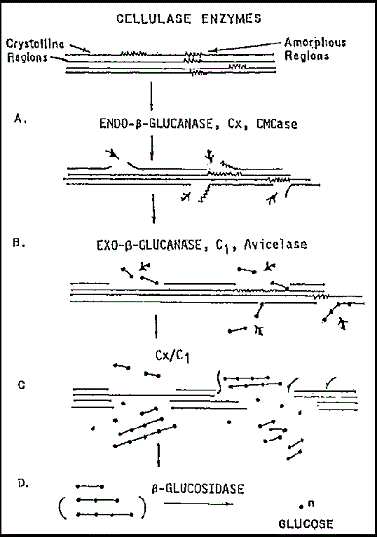
Cellulase: Application and Synthesis method
Preparation
Use Trichoderma viride as raw material for fermentation, followed by fractional precipitation of ammonium sulfate with refinement to get the products.
It is generally applied (Aspergillus Niger) or Trichoderma reesei for culturing, followed by salting out the fermentation broth for precipitation and refinement to obtain it. The resulting product contains not only cellulase, but also hemicellulase, pectinase, protease, lipase, xylanase, cellobiosease and amyloglucosidase.
References
https://www.reference.com/science/functions-enzyme-cellulase-5120d31a24f1eac8
http://www.fao.org/docrep/w7241e/w7241e08.htm
http://bioenergycenter.org/besc/publications/Zhang_cellulases_yr7.pdf
http://worldofenzymes.info/enzymes-introduction/cellulase/
Uses
Cellulase has been used to degrade cello-oligosaccharides into glucose and to study the biodegradability of bioabsorbable bacterial cellulose (BBC) material. It has been used in a study to assess the differential regulation of the cellulase transcription factors XYR1, ACE2, and ACE. It is also applied in the biodegradation of paper products such as foolscap paper, filter paper, newspaper and office paper as well as microcrystalline cellulose. It is added to detergents to improve cleansing properties.
Uses
Cellulases are enzymes that hydrolyze cellulose to glucose. Cellulase is used to study the development of occupational asthma in the detergent, pharmaceutical, baking, and enzyme production industries. Cellulase is added to detergents to improve cleansing properties. Cellulase from Sigma has been used to degrade cello-oligosaccharides into glucose while investigating the biodegradability of bioabsorbable bacterial cellulose (BBC).
Uses
Cellulase from Aspergillus niger has been used:
- in the preparation of the standardized solution to determine absolute cellulase levels
- in phosphate-citric acid buffer for activity assay
- in non-starch polysaccharide degrading enzyme cocktail for in vitro hydrolysis of defatted rice bran and in the approach to improve the nutritive value of poultry feed
Definition
An enzyme complex, produced by the fungi Aspergillus niger and Trichoderma viride that is capable of decomposing cellulosic polysaccharides into smaller fragments, primarily glucose. It has been used as a digestive aid in medicine and in the brewing industry. Research has been devoted to experimental application of cellulase to disposal of cellulosic solid wastes. The resulting glucose can be fermented to ethanol, used to grow yeast for animalfeed proteins, or used as a chemical feedstock.
General Description
This product has been enhanced for energy efficiency and waste prevention when used in cellulosic ethanol research.
Flammability and Explosibility
Not classified
Biochem/physiol Actions
Cellulases are enzymes that hydrolyze cellulose to glucose. Cellulase is used to study the development of occupational asthma in the detergent, pharmaceutical, baking, and enzyme production industries. Cellulase is added to detergents to improve cleansing properties. It is also applied in the biodegradation of paper products such as foolscap paper, filter paper, newspaper and office paper as well as microcrystalline cellulose.
cellulase Preparation Products And Raw materials
| Supplier | Tel | Country | ProdList | Advantage | |
|---|---|---|---|---|---|
| Henan Bao Enluo International TradeCo.,LTD | +86-17331933971 +86-17331933971 | deasea125996@gmail.com | China | 2503 | 58 |
| Hebei Mojin Biotechnology Co., Ltd | +8613288715578 | sales@hbmojin.com | China | 12457 | 58 |
| Hebei Yanxi Chemical Co., Ltd. | +8617531190177 | peter@yan-xi.com | China | 5993 | 58 |
| Henan Fengda Chemical Co., Ltd | +86-371-86557731 +86-13613820652 | info@fdachem.com | China | 7613 | 58 |
| Sigma Audley | +86-18336680971 +86-18126314766 | nova@sh-teruiop.com | China | 525 | 58 |
| Henan Tianfu Chemical Co.,Ltd. | +86-0371-55170693 +86-19937530512 | info@tianfuchem.com | China | 21695 | 55 |
| Nanjing ChemLin Chemical Industry Co., Ltd. | 025-83697070 | product@chemlin.com.cn | CHINA | 3012 | 60 |
| Shanghai Zheyan Biotech Co., Ltd. | 18017610038 | zheyansh@163.com | CHINA | 3620 | 58 |
| career henan chemical co | +86-0371-86658258 | sales@coreychem.com | China | 29914 | 58 |
| SHANDONG ZHI SHANG CHEMICAL CO.LTD | +86 18953170293 | sales@sdzschem.com | China | 2931 | 58 |
Related articles
- Health benefits of Cellulase
- Cellulase is a class of enzymes produced by the fungi bacteria and protozoans that generate cellulolysis. This process is actu....
- Sep 16,2019
View Lastest Price from cellulase manufacturers
| Image | Update time | Product | Price | Min. Order | Purity | Supply Ability | Manufacturer | |
|---|---|---|---|---|---|---|---|---|
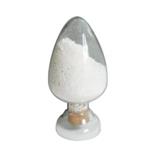 |
2024-04-23 | cellulase
9012-54-8
|
US $14.00-11.00 / kg | 1kg | 99.99% | 200Tons | Hebei Dangtong Import and export Co LTD | |
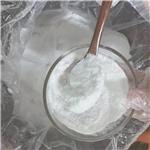 |
2024-03-12 | cellulase
9012-54-8
|
US $35.00-25.00 / kg | 1kg | 99.8% | 200tons/year | Sigma Audley | |
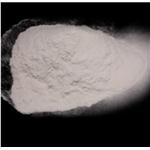 |
2023-12-23 | cellulase
9012-54-8
|
US $50.00-1.00 / KG | 1KG | 99% | g-kg-tons, free sample is available | Henan Fengda Chemical Co., Ltd |
9012-54-8(cellulase)Related Search:
1of4




